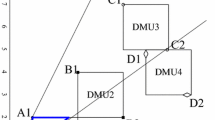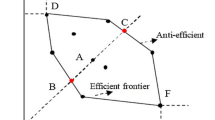Abstract
Cross-efficiency evaluation is a useful approach to ranking decision making units (DMUs) in data envelopment analysis (DEA). The possible existence of multiple optimal weights for the DEA may reduce the usefulness of the cross-efficiency evaluation since the ranking is according to the choice of weights that different DMUs make. Most of existing approaches for cross-efficiency evaluation employ the average cross-efficiency to further discriminate among the DEA efficient units or focus on how to determine input and output weights uniquely, but lay little emphasis on the consideration of the ranges and variances of cross-efficiencies as alternative ranking factors. In this paper we consider cross-efficiency intervals and their variances for ranking DMUs. The aggressive and benevolent formulations are taken into account at the same time. Consequently, a number of cross-efficiency intervals is obtained for each DMU. The signal-to-noise (SN) ratio, originally designed for optimizing the robustness of a process, is constructed as a numerical index for ranking DMUs. A nonlinear fractional program with bound constraints is formulated to find the optimal value of the SN ratio. By model reduction and variable substitution, this nonlinear fractional program is transformed into a quadratic one for deriving the global optimum solution. With the derived SN ratios, we are able to fully rank all DMUs accordingly. Two examples are given to illustrate the effectiveness of the methodology proposed in this paper.
Similar content being viewed by others
Notes
As a nonparametric method, DEA models require much more observations than parametric methods to get a good estimation. A rule of thumb is the number of DMUs should be at least three times than the total numbers of input and output variables (Cooper et al. 2007). Without an appropriate statistical test to check the change in the technology (or production set), it is dangerous to pool the data from two time periods, since the technology could be changed. Therefore, we only use the observations, the 22 commercial banks in 2013, as the dataset to demonstrate the new approach.
References
Alcaraz, J., Ramón, N., Ruiz, J. L., & Sirvent, I. (2013). Ranking ranges in cross-efficiency evaluations. European Journal of Operational Research, 226, 516–521.
Aly, H. Y., Grabowski, R., Pasurka, C., & Rangan, N. (1990). Technical scale, and allocative efficiencies in U.S. banking: An empirical investigation. The Review of Economics and Statistics, 72, 211–218.
Anderson, T. R., Hollingsworth, K. B., & Inman, L. B. (2002). The fixed weighting nature of a cross-evaluation model. Journal of Productivity analysis, 17, 249–255.
Baker, P. C., & Talluri, S. (1997). A closer look at the use of data envelopment analysis for technology selection. Computers & Industrial Engineering, 32, 101–108.
Bazaraa, M. S., Sherali, H. D., & Shetty, C. M. (1993). Nonlinear programming-theory and algorithm (2nd ed.). New York: Wiley.
Benson, H. P. (2006). Fractional programming with convex quadratic forms and functions. European Journal of Operational Research, 173, 351–369.
Boussofiane, A., Dyson, R. G., & Thanassoulis, E. (1991). Applied data envelopment analysis. European Journal of Operational Research, 52, 1–15.
Chang, C. T. (2002). On the posynomial fractional programming problem. European Journal of Operational Research, 143, 42–52.
Charnes, A., & Cooper, W. W. (1962). Programming with linear fractional functional. Naval Research Logistics Quarterly, 9, 181–186.
Charnes, A., Cooper, W. W., & Rhodes, E. (1978). Measuring the efficiency of decision making units. European Journal of Operational Research, 2, 429–444.
Cooper, W. W., Seiford, L. M., & Tone, K. (2007). Data envelopment analysis: A comprehensive text with models, applications, references and DEA-solver software. Berlin: Springer.
Despotis, D. K. (2002). Improving the discriminating power of DEA: Focus on globally efficient units. Journal of the Operational Research Society, 53, 314–323.
Doyle, J. R., & Green, R. H. (1994). Efficiency and cross efficiency in DEA: Derivations, meanings and uses. Journal of the Operational Research Society, 45, 567–578.
Du, F., Cook, E. D., Liang, L., & Zhu, J. (2014). Fixed cost and resource allocation based on DEA cross-efficiency. European Journal of Operational Research, 235, 206–214.
Falagario, M., Sciancalepore, F., Costaniyo, N., & Pietroforte, R. (2012). Using a DEA-cross efficiency approach in public procurement tenders. European Journal of Operational Research, 218, 523–529.
Fowlkes, W. Y., & Creveling, C. M. (1995). Engineering methods for robust product design. Boston, MA: Addison-Wesley.
Hladík, M. (2010). Generalized linear fractional programming under interval efficiency. European Journal of Operational Research, 205, 42–46.
Hsiao, H. C., Chang, H., Cianci, A. M., & Huang, L. H. (2010). First Financial Restructuring and operating efficiency: Evidence from Taiwanese commercial banks. Journal of Banking & Finance, 2010(34), 1461–1471.
Jahanshahloo, G. R., Hosseinzadeh Lofti, F., Jafari, Y., & Maddahi, R. (2011). Selecting symmetric weights as a secondary goal in DEA cross-efficiency evaluation. Applied Mathematical Modelling, 35, 544–549.
Kao, C., & Liu, S. T. (2009). Stochastic data envelopment analysis in measuring the efficiency of Taiwan commercial banks. European Journal of Operational Research, 2009(196), 312–322.
Kao, C., & Liu, S. T. (2014). Measuring performance improvement of Taiwanese commercial banks under uncertainty. European Journal of Operational Research, 235, 755–764.
Lahdelma, R., & Salminen, P. (2001). SMAA_2: Stochastic multicriteria acceptability anyalysis for group decision making. Operations Research, 49, 444–454.
Lam, K. F. (2010). In the determination weight sets to compute cross-efficiency ratios in DEA. Journal of the Operational Research Society, 61, 134–143.
Liang, L., Wu, J., Cook, W. D., & Zhu, J. (2008a). The DEA game cross efficiency model and its Nash equilibrium. Operations Research, 56, 1278–1288.
Liang, L., Wu, J., Cook, W. D., & Zhu, J. (2008b). Alternative secondary goals in DEA cross efficiency evaluation. International Journal of Production Economics, 113, 1025–1030.
Lim, S. (2012). Minimax and maxmini formulations of cross-efficiency in DEA. Computers & Industrial Engineering, 62, 101–108.
Lim, S., Oh, K. W., & Zhu, J. (2014). Use of DEA cross-efficiency evaluation in portfolio selection: An application to Korean stock market. European Journal of Operational Research, 236, 361–368.
Liu, S. T. (2016). Fractional transportation problem with fuzzy parameters. Soft Computing, 20, 3629–3636.
Lu, W. M., & Lo, S. F. (2007). A closer look at the economic-environmental disparities for regional development in China. European Journal of Operational Research, 183, 882–894.
Oral, M., Kettani, O., & Lang, P. (1991). A methodology for collective evaluation and selection of industrial R&D projects. Management Science, 37, 871–885.
Oral, M., Oukil, A., Malouin, J.-L., & Kettani, O. (2014). The appreciative democratic voice of DEA: A case of faculty academic performance evaluation. Socio-Economic Planning Sciences, 48, 20–28.
Oral, M., Amin, G. R., & Oukil, A. (2015). Cross-efficiency in DEA: A maximum resonated appreciative model. Measurement, 63, 159–167.
Oukil, A., & Amin, G. R. (2015). Maximum appreciative cross-efficiency in DEA: A new ranking method. Computers & Industrial Engineering, 81, 14–21.
Örkcü, H. H., Ünsal, M. G., & Bal, H. (2015). A modification of a mixed integer linear programming (MILP) model to avoid the computational complexity. Annals of Operations Research, 235, 599–623.
Pardalos, P. M. (1986). An algorithm for a class of nonlinear fractional problems using ranking of the vertices. BIT, 26, 392–395.
Ramón, N., Ruiz, J. L., & Sirvent, I. (2011). Reducing differences between profiles of weights: A ”peer restricted” cross-efficiency evaluation. OMEGA, 39, 634–641.
Ramón, N., Ruiz, J. L., & Sirvent, I. (2014). Dominance relations and ranking of units by using interval number ordering with cross-efficiency intervals. Journal of the Operational Research Society, 65, 1336–1343.
Sexton, T. R., Silkman, R. H., & Hogan, A. J. (1986). Data envelopment analysis: Critique and extensions. In R. H. Silkman (Ed.), Measuring efficiency: An assessment of data envelopment analysis. San Francisco, CA: Jossey-Bass.
Su, C. T. (2013). Quality Engineering: Off-line methods and applications. Boca Raton: CRC Press.
Sun, S. (2002). Assessing computer numerical control machines using data envelopment analysis. International Journal of Production Research, 40, 2011–2039.
Taguchi, G., Chowdhury, S., & Wu, Y. (2005). Taguchi’s quality engineering handbook. Hoboken, NJ: John Wiley & Sons.
Vavasis, S. A. (1991). Nonlinear optimization: Complexity issues. New York: Oxford University Press.
Wang, Y. M., & Chin, K. S. (2010). A neural DEA model for cross-efficiency evaluation and its extension. Expert Systems with Applications, 37, 3666–3675.
Wang, Y. M., Chin, K. S., & Jiang, P. (2011). Weight determination in the cross-efficiency evaluation. Computers & Industrial Engineering, 61, 497–502.
Wang, C. F., & Shen, P. P. (2008). A global optimization algorithm for linear fractional programming. Applied Mathematics and Computation, 204, 281–287.
Wheelock, D. C., & Wilson, P. W. (1999). Technical progress, inefficiency, and productivity changes in U. S. banking 1984–1993. Journal of Money, Credit, and Banking, 31, 212–234.
Wong, Y. H. B., & Beasley, J. E. (1990). Restricting weight flexibility in data envelopment analysis. Journal of the Operational Research Society, 41, 829–835.
Wu, J., Liang, L., & Yang, F. (2009). Achievement and benchmarking of countries at the summer Olympics using cross efficiency evaluation method. European Journal of Operational Research, 197, 722–730.
Wu, J., & Liang, L. (2012). A multiple criteria ranking method based on game cross-evaluation approach. Annals of Operations Research, 197, 191–200.
Wu, J., Sun, J., & Liang, L. (2012). Cross efficiency evaluation method based on weight-balanced data envelopment analysis model. Computers & Industrial Engineering, 63, 513–519.
Yang, F., Ang, S., Xia, Q., & Yang, C. (2012). Ranking DMUs by using interval DEA cross efficiency matrix with acceptability analysis. European Journal of Operational Research, 223, 483–488.
Yu, M. M., Ting, S. C., & Chen, M. (2010). Evaluating the cross efficiency of information sharing in supply chains. Expert Systems with Applications, 37, 2891–2897.
Acknowledgements
Research was supported by the Ministry of Science and Technology of Taiwan under Contract No. MOST104-2410-H-238-002-MY2. The author is indebted to the editor and the reviewers that significantly improve the quality of the paper.
Author information
Authors and Affiliations
Corresponding author
Rights and permissions
About this article
Cite this article
Liu, ST. A DEA ranking method based on cross-efficiency intervals and signal-to-noise ratio. Ann Oper Res 261, 207–232 (2018). https://doi.org/10.1007/s10479-017-2562-8
Published:
Issue Date:
DOI: https://doi.org/10.1007/s10479-017-2562-8




